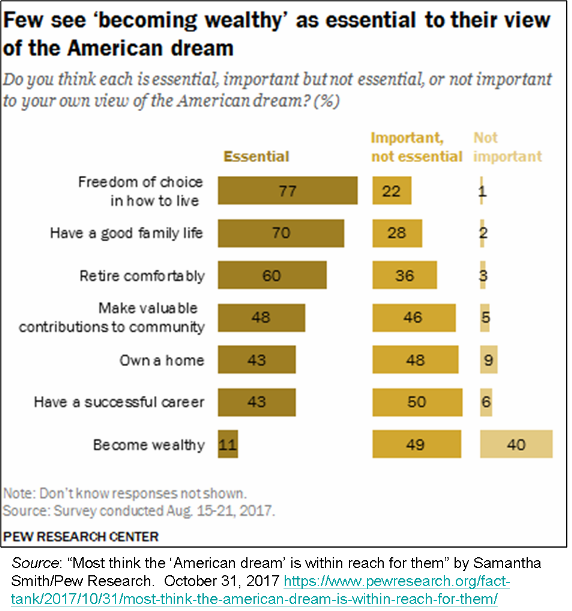Academics are always writing about how the American Dream is dead or dying (or words to that effect). A few recent examples:
The fading American dream: Trends in absolute income mobility since 1940
Enlightened racism: The Cosby Show, audiences, and the myth of the American dream
The great risk shift: The new economic insecurity and the decline of the American dream
Paying the price: College costs, financial aid, and the betrayal of the American dream
The American Dream: Slipping Away?
Requiem for the American dream: The 10 principles of concentration of wealth & power
American Dream Turns to Nightmare: The Decline of the United States Middle Class
It may come as some surprise, then, that the American Dream appears to be alive and well - at least, if you asked regular folk and not academics with a political agenda. According to a 2017 Pew Research survey, over 80% of respondents said their family had achieved or were on their way to achieving the American Dream. And 70% of respondents in a 2019 Gallup poll believed that the American Dream is achievable as long as you work hard and play by the rules*.
Why such a gap in perceptions between the public and academia? Different definitions is why. Many research studies define the American Dream in terms that most Americans do not consider all that important, e.g., doing better than one’s parents or achieving a certain level of wealth. Some in the academic (and political) community seem to assume that the fact of high inequality in itself makes a mockery of the American Dream. But inequality doesn’t bother Americans all that much. Every month Gallup asks hundreds of survey participants the open-ended question “What do you think is the most important problem facing the country today?” In last month’s survey, just 2% of respondents mentioned the gap between rich and poor. As Starmans and Bloom (2017) noted, “contrary to appearances, people are not troubled by inequality for its own sake; indeed, they often prefer unequal distributions, both in laboratory conditions and in the real world.”
So what does matter to Americans? That is, what are the essentials of their own version of the American Dream? Allowing that the American Dream means different things to different people, there are some things that most Americans care deeply about: freedom, family, and a comfortable retirement (followed by contributing to the community and then owning a home). That’s according to a survey conducted by Pew Research a couple years ago. Check it out:
Is it any wonder that so many Americans grumble about “out-of-touch” elites?
—
* The somewhat lower percentage of American Dream believers in the 2019 Gallup poll appears due to what the pollster referred to as the “growing partisan gap in perceptions of the attainability of the American dream”: just 60% of Democrats polled thought the Dream was achievable via hard work and playing by the rules. Ironically, another Gallup poll found liberal Democrats to be the most educated of those surveyed (and hence more likely to achieve the American Dream themselves).
References:
Define and Thou Shalt Conclude: The Case of the American Dream (2018) Exploring The Problem Space
Most Americans See American Dream as Achievable by Mohamed Younis/ Gallup July 17, 2019
Most think the ‘American dream’ is within reach for them by Samantha Smith/Pew Research Center October 31, 2017
Starmans, C., Sheskin, M. & Bloom, P. Why people prefer unequal societies. Nature Human Behavior 1, 0082 (2017) DOI: https://doi.org/10.1038/s41562-017-0082
